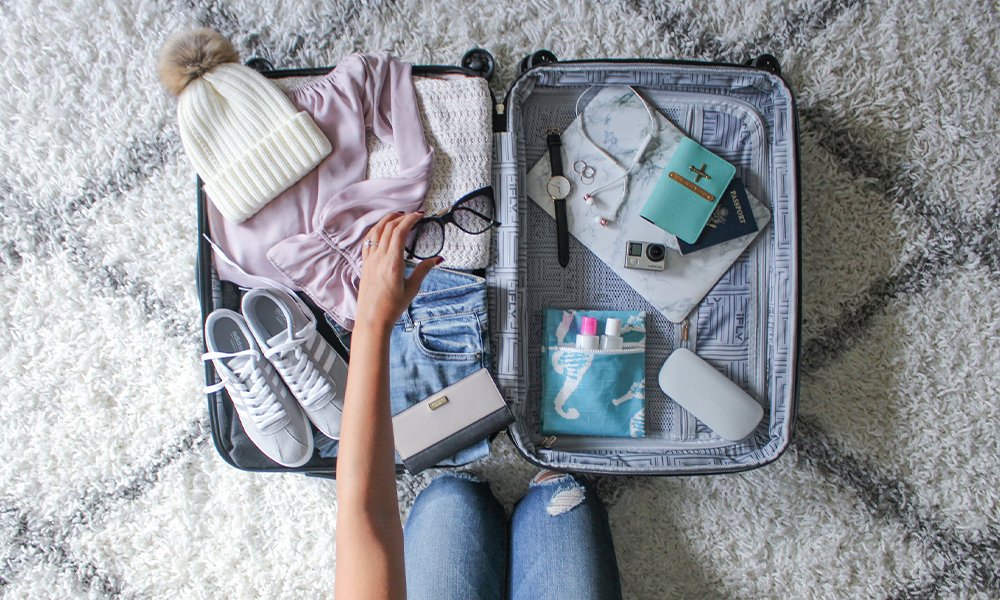Packing for a long-term trip can be tricky. You want to bring enough to be comfortable, but not so much that it becomes a burden. Whether you’re planning a backpacking adventure, an extended business trip, or a leisurely exploration of new places, packing smart can make a big difference. Here’s your guide to packing like a pro for long-term travel!
1. Choose the right luggage
Your choice of luggage will set the foundation for how well you’ll pack. Consider what’s most practical for your travels:
Backpack or suitcase?: A backpack is ideal for people who travel frequently, tackle rough terrain, or use public transportation. A suitcase might be more appropriate if you’re staying in one place for a longer period of time or if you prefer easy organization and flexibility when packing.
Size matters: Limit yourself to one main piece of luggage, around 50-70 liters for a backpack or medium-sized suitcase. The smaller the bag, the less tempted you will be to overpack.

Daypack: Pack a lightweight, foldable daypack that can also be used as an everyday bag. It’s perfect for trips, day tours, and for bringing essentials on flights or buses.
2. Limit essentials and versatile clothing
Choosing the right clothes is crucial for a longer trip. Focus on versatility and pack pieces that can be mixed and matched.
Stay neutral: Neutral colors like black, white, navy, and gray are easy to mix and match. They also hide dirt and wrinkles better than bright colors.
Layers are key: Pack light layers that you can put on or take off depending on the weather. Think t-shirts, long-sleeved shirts, a light sweater, and a jacket.
Limit specialty items: Don’t pack clothes that you would only wear once or on specific occasions. A simple, versatile outfit is suitable for a range of activities, from casual days to dressier evenings.
Roll, don’t fold: Rolling clothes saves space and helps prevent wrinkles. Use packing cubes to separate different types of clothing, making organization easier.
3. Invest in travel-friendly fabrics
The material of your clothes can affect their comfort, weight, and ease of care during a long trip. Look for fabrics that are lightweight, quick-drying, and wrinkle-resistant.
Merino wool: This fabric is breathable, temperature-regulating, and naturally odor-resistant. It’s great for long trips because you can wear it again without the risk of odor.
Synthetic fabrics: Nylon and polyester are both lightweight and quick-drying, making them great choices for travel clothing.
Avoid heavy fabrics: Jeans and thick sweaters can take up a lot of space. If you need them, limit yourself to one pair of jeans or a sweater.
4. Limit shoes and accessories
3-pair rule for shoes: Bring no more than three pairs—a comfortable walking shoe, a lightweight sandal or slipper, and a versatile dress shoe if needed. Wear your bulkiest pair when traveling to save space.
3-pair rule for shoes: Bring no more than three pairs—a comfortable walking shoe, a lightweight sandal or slipper, and a versatile dress shoe if needed. Wear your bulkiest pair when traveling to save space.

Minimal accessories: Limit yourself to a watch, sunglasses, and maybe a few lightweight pieces of jewelry. Scarves or sarongs are versatile and can be used as blankets, capes, or even beach towels.
5. Limit the number of toiletries to a minimum
Toiletries can add a lot of weight, so keep them simple. Look for travel-sized products or consider purchasing them at your destination.
Limit to essentials: Bring only the basics, like a toothbrush, toothpaste, deodorant, and shampoo. If you run out, you can usually buy replacements along the way.
Solid products: Consider solid alternatives to liquid toiletries like solid shampoo and conditioner, solid soap, and even solid perfume. They last longer and won’t leak in your bag.
Reusable travel bottles: If you need liquid products, invest in reusable travel bottles. Fill them with products from home and refill them as needed on your travels.
6. Get organized with packing cubes and zip-lock bags
Keeping things organized when living out of a suitcase can be a challenge. Packing cubes and zip-lock bags make it easier to find items without having to unpack everything.
Packing cubes: Use packing cubes to separate your clothes by type (e.g. tops, bottoms, underwear) or by outfit. This makes packing and repacking easier.
Compression bags: If you need to pack bulky items, compression bags can help save space. Just be careful not to overpack, as compressed items still add weight.
Zip-lock bags for small items: Use small zip-lock bags for items like chargers, medications, and toiletries. This will keep them organized and prevent spills or tangling.
7. Only take essential electronics
Electronics can add weight quickly, so only pack what you really need. Here’s a simplified list:
Smartphone: Your phone can serve as a camera, map, translator, and more. Make sure it’s unlocked if you plan on buying a local SIM card.
Universal adapter and charger: A universal adapter will allow you to charge your devices anywhere in the world. Consider a compact power bank for extra charging on the go.
Laptop or tablet (if necessary): Only bring a laptop or tablet if it’s essential for work or personal use. A tablet is lighter, but if you have a lot of work to do, a laptop may be worth the weight.
8. Bring a compact travel first aid kit
A basic first aid kit can be invaluable on a long trip. Pack things like:
Pain relievers: Ibuprofen or aspirin can be useful for everything from headaches to muscle aches.
Band-Aids and antiseptic wipes: For minor cuts or blisters.

Prescription medications: Bring enough for your entire trip, as some prescriptions may be difficult to refill while abroad.
Personal supplies: If you have allergies, bring antihistamines or other necessary medical supplies.
9. Pack multipurpose items
Multipurpose items are a long-term traveler’s best friend. They save space and provide flexibility for different situations.
Sarong or large scarf: Can be used as a beach towel, blanket, picnic mat, or even a pillow.
Lightweight rain jacket: A good rain jacket can also double as a windbreaker. Look for one that is easy to fold and store.
Foldable water bottle: Hydration is essential. A foldable water bottle takes up little space and can be refilled on the go.
10. Prepare for laundry
Since you’re traveling long-term, it’s important to have a plan for laundry. Here’s how to do it:
Portable laundry kit: Bring a small laundry bag, some laundry detergent sheets, and a sink plug. With this equipment, you can do laundry at your accommodation if needed.
Laundry day: Many places offer inexpensive laundromats or laundry services. Schedule a laundry day into your routine to keep your clothes fresh and ready to go.
Quick-drying clothes: Choose quick-drying fabrics that are easier to wash and dry overnight.
Bottom line
Packing like a pro for a long-term trip is all about finding the right balance between comfort and practicality. With a little planning, you can pack light and still have everything you need for an unforgettable trip. Choose versatile clothing, bring only the essentials, and keep toiletries and accessories to a minimum. Follow these tips, and you’ll be ready to explore the world without lugging around excess baggage. Happy travels!




No Comment! Be the first one.